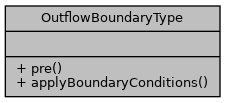#include <OutflowBoundaryType.h>
Collaboration diagram for OutflowBoundaryType:

Static Public Member Functions | |
| static void | pre (LinkedCellsContainer &container) |
| Applies the preconditioning step for the outflow boundary condition. More... | |
| static void | applyBoundaryConditions (LinkedCellsContainer &container) |
| Applies the boundary conditions for the outflow boundary condition. More... | |
Detailed Description
Definition at line 7 of file OutflowBoundaryType.h.
Member Function Documentation
◆ applyBoundaryConditions()
|
static |
Applies the boundary conditions for the outflow boundary condition.
- Parameters
-
container The container to apply the boundary conditions to.
This method is empty, as the outflow boundary condition does not require any special treatment.
Definition at line 57 of file OutflowBoundaryType.cpp.
◆ pre()
|
static |
Applies the preconditioning step for the outflow boundary condition.
- Parameters
-
container The container to apply the boundary conditions to.
This method removes all particles from the container that are in halo cells with the outflow boundary condition.
Definition at line 7 of file OutflowBoundaryType.cpp.
std::vector< Particle * > & getParticleReferences()
Get the reference vector for the particles the cell contains.
Definition: Cell.cpp:7
std::vector< Cell * > right_halo_cell_references
References to the halo cells on the right (x = domain_num_cells[0])
Definition: LinkedCellsContainer.h:387
std::vector< Cell * > front_halo_cell_references
References to the halo cells on the front (z = domain_num_cells[2])
Definition: LinkedCellsContainer.h:407
std::vector< Cell * > bottom_halo_cell_references
References to the halo cells on the bottom (y = -1)
Definition: LinkedCellsContainer.h:392
std::vector< Cell * > left_halo_cell_references
References to the halo cells on the left (x = -1)
Definition: LinkedCellsContainer.h:382
std::vector< Cell * > top_halo_cell_references
References to the halo cells on the top (y = domain_num_cells[1])
Definition: LinkedCellsContainer.h:397
std::vector< Cell * > back_halo_cell_references
References to the halo cells on the back (z = -1)
Definition: LinkedCellsContainer.h:402
std::array< BoundaryCondition, 6 > boundary_types
The boundary types for each side of the domain (order in array: left, right, bottom,...
Definition: LinkedCellsContainer.h:313
std::vector< Particle > particles
Internal data structure for the particles.
Definition: LinkedCellsContainer.h:298
The documentation for this class was generated from the following files: